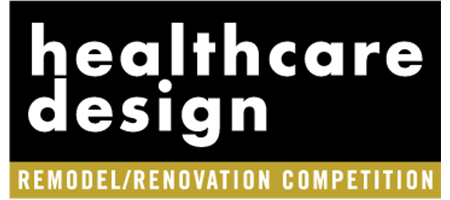2024 Breaking Through Conceptual Design Competition
The 2024 Healthcare Design Conference + Expo in Indianapolis hosted Healthcare Design’s fourth Breaking Through conceptual design competition, charging teams to challenge the status quo in healthcare design without regulation, code, or budget constraints.
Four finalist teams representing SmithGroup, HGA, Perkins&Will, and Gresham Smith competed for the $10,000 grand prize.
The competition began earlier this year, with teams submitting concept statements addressing future healthcare challenges and innovative solutions.
From 13 semifinalists (meet the semifinalists here) selected by a jury of industry experts, the four finalists advanced to present live at the conference. Each team had 10 minutes to showcase their ideas, with attendees voting in real time to select the winner.
Prior to the finale, the teams first submitted concept statements that detailed a challenge they anticipated in the future delivery of healthcare and their proposed limit-pushing solution for it.
Here, Healthcare Design presents the 2024 finalist—HGA’s Oasis.
Oasis: 2024 Breaking Through Finalist
Team: HGA
On-stage presenters: Tanya Chadha, senior associate, senior medical planner; Bryce Hubertz, associate vice president, senior project designer; Jesse Robinson, associate vice president, senior medical planner
The premise: Across the globe, children are being exposed to growing crises, including armed conflicts, mass shootings, family displacement, and abuse. Childhood trauma can have a long-term effect on mental and physical health, especially among youth who are the most vulnerable. Early intervention, including therapies such as Trauma-Focused Cognitive Behavioral Therapy (TF-CBT), help children heal through the brain’s neuroplasticity, which enables it to form new pathways throughout one’s life, helping to prevent negative outcomes in adulthood. Oasis aims to empower children to navigate their healing journey.

Image credit: HGA (AI generated image)
The concept: Building on the benefits of TF-CBT, Oasis creates an interactive environment in which neural pathways can be repaired and reworked. Using advanced technology, Oasis scans a user’s brain and reconstructs physical and projected spaces based on positive memories, such as a forest from a family trip or a holiday celebration, as well as adjusts scents, sounds, temperature, and textures to further enhance the experience. Children can use the setting for playing, relaxing, or engaging in therapy. The more time spent in Oasis, the more positive memories are reinforced, and neural pathways are repaired.
The details: The inflatable architecture reshapes itself to accommodate individuals or groups and can adapt to various locations, from residential settings to trauma situations like natural disasters or post-violence interventions. Additionally, Oasis can project an AI-generated therapist in a comforting form such as an animal or cartoon, to guide and monitor a child’s experience. The versatile healing tool is easy to set up and its adaptability to different locations means it can improve access to care, including in rural areas experiencing a shortage of facilities and care professionals.
For more on Healthcare Design’s 2024 Breaking Through competition, read here.
Anne DiNardo is editor-in-chief of Healthcare Design. She can be reached at [email protected].











